TATTOO REMOVAL SCIENCE
Information for Medical Practitioners
This page and its contents are specifically intended for the use of medical practitioners and professionals. The materials, along with the clinical trial findings provided, aim to instil confidence in medical practitioners and professionals as they refer their patients to SWIPE Clinics, ensuring those patients receive excellent outcomes and high-quality care. SWIPE exclusively use the PicoWay laser due to its superior outcomes.
Access Additional Tattoo Removal Information Guide Here
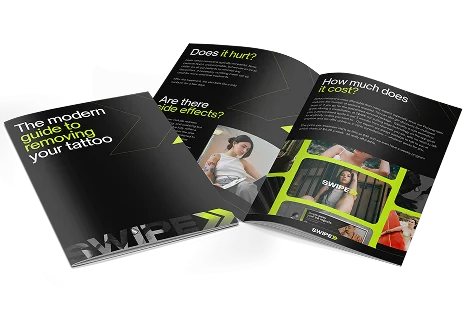
Multiple Treatments
To achieve complete tattoo removal, several laser treatments are generally necessary. Each session breaks down the ink particles further, making them progressively smaller and easier for the lymphatic system to eliminate. The skin also needs time to heal between treatments, and for tattoos with larger or thicker pigment layers, higher energy levels or additional sessions may be required to effectively address the deeper layers of ink.
Mechanisms of action for Picosecond Lasers in Tattoo Removal
The operation of picosecond lasers in tattoo removal incorporates both thermal and acoustic pressures, which are influenced by various factors, including laser fluence, pulse duration, wavelength, and the characteristics of the ink particles. Here are the critical aspects to consider:
Thermal Pressure and Particle Fracturing
For laser pulses lasting between 300-500 picoseconds (ps), the thermal pressure produced is affected by:
Laser Fluence
The energy delivered over a specific area.
Absorption Coefficient
The extent to which the laser energy is absorbed by the tattoo particles.
Particle Size
The square of the radius of the particle influences the generated pressure.
Pulse Duration
Shorter pulses result in less time for heat to dissipate, concentrating energy in a brief period, thus increasing thermal pressure.
Overall, thermal stress can lead to the fracturing of particles, although larger particles require higher fluence for effective fragmentation. However, excessive fluence can result in unwanted effects like skin scarring or pigmentation changes. Therefore, determining an optimal fluence is essential to fracture ink particles while minimizing significant tissue damage.
Selective Photothermolysis
Selective photothermolysis is the fundamental principle behind optimizing laser tattoo removal. This principle encompasses selecting:
The Appropriate Laser Wavelength
It must be effective in absorbing the ink colour while avoiding absorption by surrounding tissue components such as melanin or hemoglobin.
Shorter Laser Pulses
These should be less than the thermal relaxation time (the duration for the ink particle to cool down post laser absorption). This approach allows for effective treatment with lower fluences, thereby reducing the risk of harming nearby tissue.
As the ink particles diminish in size through successive treatments, shorter laser pulses become necessary for safe and efficient treatment. Picosecond lasers have gained recognition for their precision in breaking down faded tattoo ink, which diminishes the need for high fluence levels.
Importance of Pulse Duration and Acoustic Pressure
As pulse duration decreases, the acoustic pressure generated by the laser becomes increasingly important, especially concerning larger ink particles. Shorter pulses yield higher peak powers, which can produce pressure waves capable of fracturing larger particles. For example:
300-500ps Pulses
These generate acoustic pressures particularly effective for fracturing tattoo particles when the wavelength and pulse duration are appropriately selected.
Shorter Pulses (like those in the picosecond range)
These also enhance peak power, thereby improving the ability to break down ink particles without necessitating excessive fluence.
Choosing the Right Wavelength for Ink and Tissue Selectivity
Selecting the correct wavelength is critical for targeting the ink colour while minimizing thermal effects on surrounding tissues:
1064nm
This wavelength is effective for darker colours like black and certain reds but is less effective for blue and green inks due to lower absorption.
532nm
This wavelength effectively targets red, orange, and yellow inks but faces significant absorption by hemoglobin in blood, potentially causing unwanted side effects like purpura or blood-filled bullae, especially when used on green and blue inks.
785/730nm
This wavelength is highly efficient for green and blue inks, offering approximately ten times higher absorption than 1064nm. It also reduces absorption by hemoglobin in the skin, making it more selective for tattoo removal without considerable risk to the skin’s blood vessels. The 785/730nm wavelength, produced by Ti:sapphire lasers, generates very short pulses (around 300ps) and enables high peak powers, making it ideal for efficiently fracturing ink particles while minimizing skin damage.
Picosecond Laser Technology (PicoWay)
The PicoWay system employs the 785/730nm wavelength and generates pulses as short as 300ps. This brief duration results in extremely high peak powers (up to 0.28GW), effectively breaking down tattoo ink particles into smaller fragments. The Ti:sapphire lasers used enhance pulse shortening, increasing the efficacy of tattoo removal treatments, particularly for green and blue inks.
Which Lasers are Superior Based on Clinical Trials?
Comparison of Tattoo Treatment Results: Candela PicoWay vs. Nanosecond Laser
Over the last twenty years, Q-switched lasers, which emit short nanosecond pulses, have stood as the gold standard in tattoo removal. These lasers, including those that operate at wavelengths of 694 nm (Ruby laser), 755 nm (Alexandrite laser), and both 1064 nm and 532 nm (Q-switched Nd:YAG laser), have proven effective not only for tattoo removal but also for treating benign pigmented lesions.
Traditional Nanosecond Lasers
A study conducted by Prinz et al. (2004) demonstrated that Q-switched lasers utilizing nanosecond pulses were effective, with 50% of participants reporting over 75% lightening of their tattoo pigment, while 28% achieved a reduction of 51%-75%. Despite these promising results, nanosecond lasers generally necessitate multiple treatment sessions and may cause more collateral tissue damage.
Introduction Picosecond Lasers
Picosecond lasers, such as the PicoWay, have emerged as a more advanced alternative to traditional nanosecond lasers. These lasers employ ultra-short pulse durations, typically in the picosecond range, which are significantly faster than the nanosecond pulse durations utilized in conventional lasers. This difference in pulse duration enables picosecond lasers to induce rapid temperature changes in tattoo ink particles, resulting in more efficient fragmentation of the pigment. Consequently, this allows for improved ink clearance with less energy usage, thereby reducing the risk of damage to surrounding tissue.
Clinical Evidence and Comparison
Effectiveness
In comparative studies, picosecond lasers consistently outperformed their nanosecond counterparts in terms of tattoo clearance. One particular study indicated that picosecond lasers could eliminate certain tattoos using lower energy levels than nanosecond lasers, achieving quicker results.
Dr. Ross’s research confirmed that picosecond lasers are more effective than nanosecond lasers when operating at the same wavelength (1064 nm). His findings illustrated that the rapid temperature fluctuations caused by picosecond pulses led to more substantial fragmentation of ink particles and deeper penetration. Consequently, picosecond lasers required fewer treatments to achieve comparable or superior clearance, especially for challenging colours such as blue and green ink.
Safety and Side Effects
Both picosecond and nanosecond lasers exhibit similar side effect profiles, with a minimal risk of scarring. Nevertheless, picosecond lasers have shown a higher safety profile, experiencing fewer adverse events.
In Dr. Ross’s study, there was only a single instance of hyperpigmentation following picosecond laser treatment, compared to two cases of scarring associated with nanosecond lasers. Additionally, picosecond lasers were linked to less collateral damage to surrounding tissue, making them a safer choice overall.
Brauer et al. (2012) further corroborated the safety of picosecond lasers, noting that blue and green ink pigments were effectively removed in just one or two treatments, with minimal post-treatment side effects such as crusting and temporary pigmentation changes.
Treatment Duration
The primary advantage of picosecond lasers is their ability to reduce the number of required treatments. Research has indicated that patients treated with picosecond lasers, including the PicoWay device, achieved 75% clearance on average after just four treatments. In contrast, nanosecond lasers typically necessitate more sessions to attain similar results.
A 2014 multi-centre study focusing on the PicoWay device revealed that 89% of patients achieved at least 50% clearance, and 54% achieved at least 75% clearance. This underscores the superior efficiency of picosecond lasers in tattoo clearance with fewer treatments compared to traditional lasers.
Conclusion
The comparison between picosecond lasers, such as PicoWay, and nanosecond lasers highlights several significant advantages for the former. Picosecond lasers deliver faster and more effective results with fewer treatment sessions and boast a superior safety profile. The shorter pulse duration requires less energy to break down tattoo pigments, minimizing the risk of tissue damage and side effects like scarring or hyperpigmentation. Consequently, picosecond lasers are increasingly becoming the preferred option for tattoo removal, offering quicker results with reduced risk and fewer treatments than traditional nanosecond lasers.
The Importance PicoWay 785/730nm Laser for Improved Clearance Rates on Blue and Green Inks Based on Clinical Trials
The PicoWay Third Wavelength Mechanisms of Action introduce an innovative approach to enhancing the clearance of blue and green tattoos through the utilization of a 785/730nm picosecond laser. This mechanism is specifically designed to tackle the challenges associated with conventional laser tattoo removal, particularly in efficiently targeting and eliminating the pigments that are notoriously difficult to treat, such as blue and green inks. Below is a detailed summary of how the PicoWay laser operates, based on the outlined mechanisms:
Fragmentation of Ink Particles
Ink Particle Breakdown
The primary mechanism for tattoo ink removal relies on the fragmentation of pigment particles into smaller fragments when exposed to a short, high-intensity pulse from the laser. This process generates stress within the ink pigment, which leads to its breakdown into smaller pieces.
Phagocytosis
Following fragmentation, some of the resulting ink fragments are captured by macrophages, which are the immune cells responsible for removing foreign materials from the body. These smaller fragments are then transported into the lymphatic system over a period of several weeks. Ultimately, these particles may be flushed out of the body, resulting in the gradual fading of the tattoo over time.
Thermal Decomposition
Thermal Effects on Pigment
A second mechanism of action involves the generation of high temperatures within the ink pigments. This intense heat causes certain pigments (for example, carbon black and aromatic ring-based red pigments) to decompose into smaller, colourless particles that no longer exhibit their original colour. This effect is particularly effective for specific ink colours, such as those containing carbon black, which transforms into colourless carbon lattices.
Decomposition of Pigment
During this process, the pigment undergoes a transformation at the molecular level, which may aid in its overall removal by making it less visible or by breaking it down into particles small enough for macrophages to eliminate.
Ultra-Small Fragmentation
Invisible Fragmentation
The third mechanism involves ultra-short picosecond pulses that break pigment particles into extremely small fragments, typically smaller than 10nm in size. These particles are so diminutive that they become invisible, falling below the size threshold that allows interaction with visible light. This process entails a rapid expansion of the ink particles, generating high thermal stress that leads to instantaneous fragmentation.
Lymphatic Clearance
Once the particles are reduced to a sufficiently small size (less than 100nm), they become easier for the body to clear through the lymphatic system. This contributes to a more effective and expedited tattoo removal following treatment.
Thermal Stress and Confinement
Thermal Stress Mechanism
When the laser pulses heat the tattoo ink, the rapid expansion of the ink particles creates thermal stress. This stress accumulates due to the restriction imposed by the surrounding skin tissues and water, which prevents rapid expansion, resulting in increased pressure within the pigment particle. If the heating occurs quickly enough (as is the case with picosecond lasers), this leads to the fragmentation of the pigment.
Importance of Picosecond Pulses
For effective thermal stress and fragmentation, the laser must produce ultra-short picosecond pulses—ranging from 300 to 450 picoseconds. This is crucial because smaller particles (approximately 300nm or less) necessitate these brief pulses to ensure that the heat does not dissipate before the pigment has had sufficient time to fragment under pressure.
Improved Ink Clearance
Targeting Blue and Green Pigments
The PicoWay system, particularly with its 785/730nm wavelength, has been specifically engineered to enhance the clearance of blue and green ink pigments, which are traditionally more challenging to treat with conventional laser systems. The shorter wavelength enables more efficient targeting and fragmentation of these difficult pigments.
Tattoo Ink Vial Experiments
Key Insights
Effectiveness of the 785/730nm PicoWay Wavelength
The 785/730nm PicoWay wavelength demonstrates exceptional results in removing blue and green tattoo inks, outperforming older laser technologies.
Vial Experiment Comparisons
PicoWay 785nm Picosecond Pulse vs. Q-Switched 755nm Nanosecond Pulse
PicoWay 785nm Picosecond Pulse
- Achieved significant tattoo ink clearance.
- Utilizes ultra-short pulses to effectively break down pigments, even without macrophage assistance, indicating direct pigment fracturing or decomposition.
Q-Switched 755nm Nanosecond Pulse
- Produced less clearance.
- Relies more on macrophage activity for pigment removal, highlighting its less efficient mechanism.
Blue Tattoo Pigment Treatment Results
PicoWay 785nm at 1.4 J/cm²
- Superior clearance of blue pigments compared to the Q-Switched 755nm.
Clinical Study results
FDA Study
| Participants | 15 patients with 22 tattoos. |
| Focus | Blue and green inks. |
| Results | 83% of tattoos showed “good” to “complete” clearance after two treatments. |
Independent Physician Evaluations
- Blinded assessments confirmed superior results consistent with investigators’ observations.
Safety and Comfort
- No complications reported.
- Patients experienced mild or no discomfort.
Efficiency
- Outperformed 1064nm wavelength for blue and green ink removal.
Key Takeaways
- The 785nm PicoWay wavelength is highly effective for blue and green ink removal, surpassing older laser technologies.
- Clinical studies confirm its safety, efficiency, and patient comfort.
- The mechanism involves generating thermal and acoustic pressures that fracture ink particles while minimizing thermal damage.
Cosmetic Tattoo Removal with the PicoWay Laser
Introduction
Cosmetic tattoos (eyebrows, eyeliner, lips) are increasingly popular but often require removal due to outdated styles, fading, or poor results. Traditional removal methods (e.g., chemical peels, dermabrasion) were invasive and yielded unsatisfactory outcomes.
Advantages of Picosecond Lasers
- Utilizes photoacoustic effects to shatter ink particles with minimal thermal energy, reducing side effects like scarring or pigmentation changes.
- Ideal for sensitive areas like eyebrows, minimizing the risk of hair damage.
The PicoWay Laser System
Features
| Four wavelengths | 1064 nm, 785 nm, 730 nm, and 532 nm. |
| Three beam technologies | 1064 nm, 785 nm, 730 nm, and 532 nm. |
| Ultra-short pulses | (250–450 ps). |
Benefits
- Treats all Fitzpatrick Skin Types (I–VI).
- Targets multiple ink colours with precision.
- Minimises damage to surrounding tissue.
Clinical Backing
- Proven efficacy in 51 peer-reviewed studies.
Case Studies
Case 1: Eyeliner Tattoo Removal
| Patient: | 37-year-old female. |
| Treatment: | 5 sessions (10 weeks apart) with the Zoom 1064 nm handpiece. |
| Outcome: | Effective removal without complications. |
| Handpiece: | Eye shields were placed prior to treatments. |
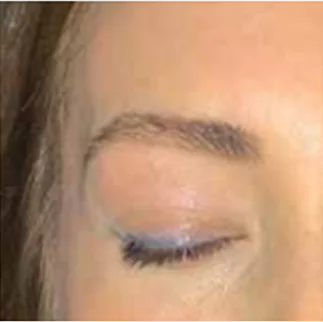
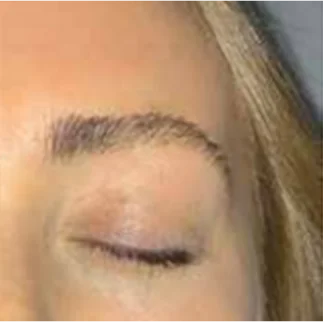
All photos are unretouched. Individual results may vary.
| Treatment | Handpiece | Spot Size (mm) | Fluence (J/cm²) |
|---|---|---|---|
| 1 | Zoom 1064 | 5 | 1.5 |
| 2 & 3 | Zoom 1064 | 5 | 1,4 |
| 4 & 5 | Zoom 1064 | 4 | 1.8 |
Case 2: Eyebrow Tattoo Removal
| Patient: | 61-year-old female. |
| Treatment: | 2 sessions with the Zoom 1064 nm handpiece. |
| Outcome: | Successful removal with minimal discomfort. |
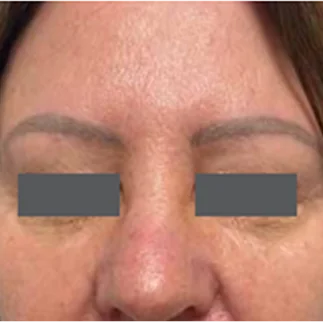
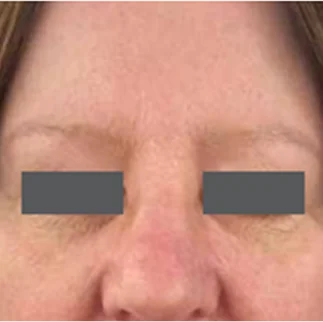
All photos are unretouched. Individual results may vary.
| Treatment | Handpiece | Spot Size (mm) | Fluence (J/cm²) |
|---|---|---|---|
| 1 | Zoom 1064 | 8 | 0.8 |
| 2 | Zoom 1064 | 6 | 1.1 |
Case 3: Lip Blush Tattoo Removal
| Patient: | 24-year-old female. |
| Treatment: | One session with the Zoom 532 nm handpiece. |
| Outcome: | Significant pigment reduction observed after 8 days. |
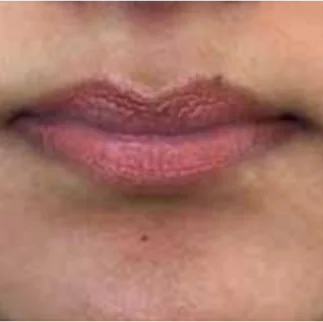
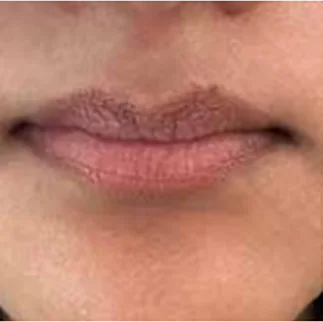
All photos are unretouched. Individual results may vary.
| Treatment | Handpiece | Spot Size (mm) | Fluence (J/cm²) |
|---|---|---|---|
| 1 | Zoom 532 | 8 | 0.28 |

